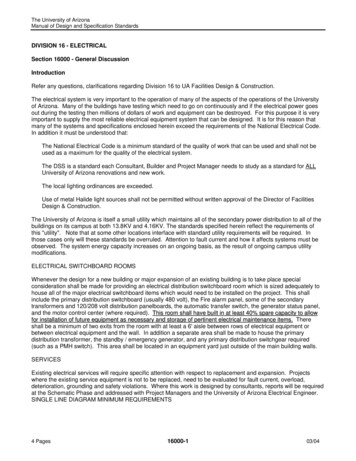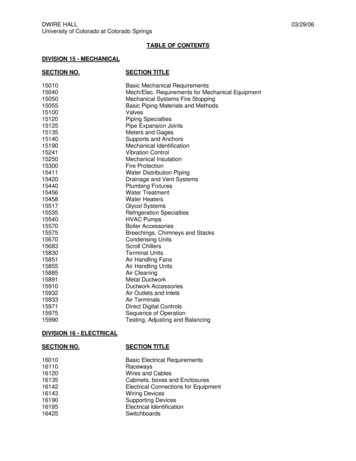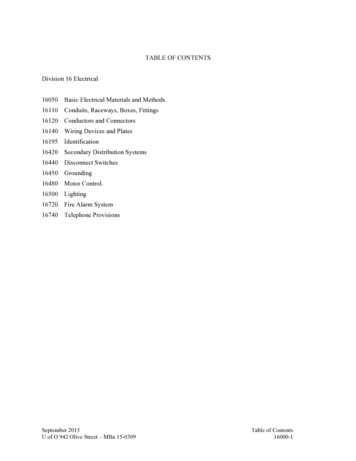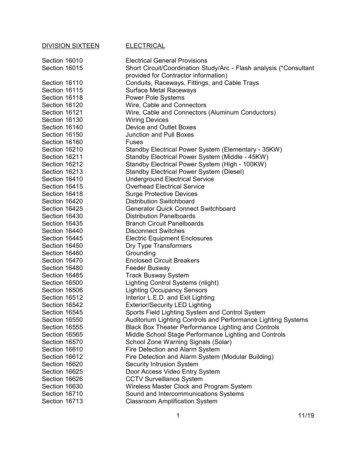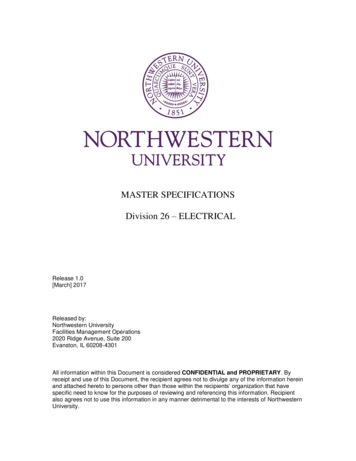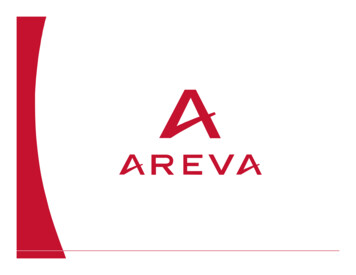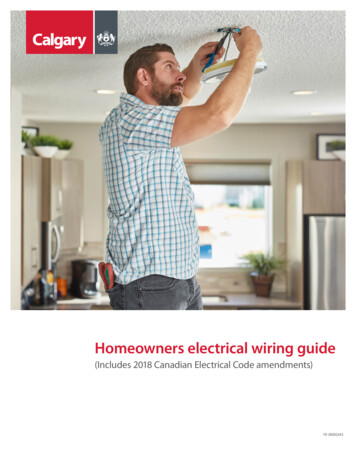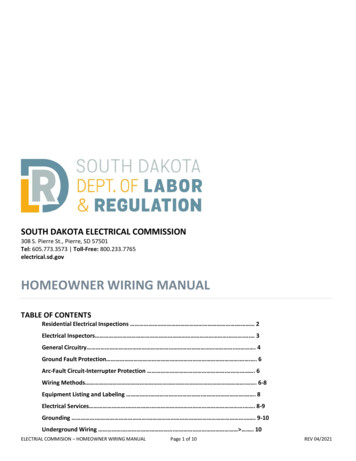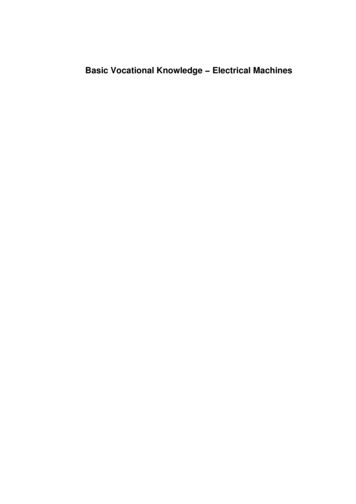
Transcription
Caltrain Standard SpecificationsSECTION 16000BASIC ELECTRICAL REQUIREMENTSPART 1 - GENERAL1.01DESCRIPTIONA.1.021.03Section includes specifications for furnishing and installation of all electricalsystems, including the checkout and startup of the systems.GENERALA.Provisions specified in this Section apply to all Division 16, Electrical.B.The types of systems covered by this Section include AC normal and emergencypower supply equipment; railroad signals, train control, and communications;station lighting, communications, and amenities; fire alarm systems; and powersupply to HVAC systems. Systems include electrically driven motors and pumps.C.The general extent of the electrical work includes furnishing and installing thefollowing items:1.Raceways, conduit, junction boxes, wire, cable and connectors requiredto inter-connect and place all equipment in complete operation.2.Power distribution systems, overcurrent protection, load transferswitches,electrical panels and switchboards, fused and unfuseddisconnects, receptacle outlets, switching, and circuits as indicated onthe Contract Drawings.3.Complete grounding systems.4.Site electrical service conduits, equipment pads, manholes, handholes,splice boxes, excavation, trenching, backfill, and compaction.5.Lighting including fixtures, lighting poles, outlets, switching, and circuits.REFERENCE STANDARDSA.Institute of Electrical and Electronics Engineers (IEEE):1.1.0481Guide for Measuring Earth Resistivity, Ground Impedance, andEarth Surface Potentials of a Ground SystemDESIGN REQUIREMENTSA.Design anchorage and secure electrical equipment in accordance with applicablecode.In addition, design anchorage and secure equipment to withstand alateral force of 0.6 times the weight of the equipment, if such requirement ismore stringent.September 30, 201116000-1BASIC ELECTRICAL REQUIREMENTS
Caltrain Standard Specifications1.05B.Size conduits, raceways, and junction boxes with minimum 20 percent spare orexpansion capacity.C.Locate electrical equipment in a manner suited to the application and install perthe original equipment manufacturers’ (OEM) recommendations and applicablecode.D.Provide circuit schedule for all lighting and power panel boards.E.Unless designed or rated for exterior use or provided with its own housing orenclosure, install electrical equipment in a manner such that it is adequatelyprotected from the local environment (such as rain and dust). Providetemperature controls (ventilating fans or air conditioning) in the enclosed spaceif the temperature will exceed the OEM recommended operating temperatures.SUBMITTALSA.Material List: Submit list of materials and equipment proposed for use in thework. Except as specified herein for "rough-in" materials, submit complete listat one time and include all proposed alternatives.1.Include name of manufacturer and where applicable, brand name, typeand/or catalog number of each item. Do not list more than onemanufacturer for any one item of equipment. Do not list items "asspecified", without both make and model or type designation.2."Rough-in" materials, such as conduit, fittings, junction boxes, 600Vpower conductors, and outlets, need not be included in the Material List,provided that these items are as specified and are listed by UL.B.Shop Drawings and Descriptive Data: As soon as practical after submission ofMaterial List, submit shop drawings and descriptive data of equipment listedhereinafter, and the required wiring diagrams. Include copies of catalog cutsincluding complete description, information, and performance data.C.Panelboard Directories: Submit for approval.D.Calculations: Submit structural calculations showing that equipment anchoragewill withstand applicable lateral force. Submit other calculations as specified inindividual Sections. Calculations shall be signed and sealed by professionalengineer licensed in the State of California.E.Manufacturer Seismic Qualification Certification:Submit certification thatpanelboards, overcurrent protective devices, accessories, and components willwithstand seismic forces according to applicable code and other Contractrequirements, whichever is most stringent. Include the following:1.September 30, 2011Basis of Certification: Indicate whether withstand certification is basedon actual test of assembled components or on calculation.16000-2BASIC ELECTRICAL REQUIREMENTS
Caltrain Standard Specifications1.06The term “withstand” means the unit will remain in place withoutseparation of internal and external parts during a seismic event and theunit will be fully operational after the event.3.Dimensioned Outline Drawings of Equipment Unit: Identify center ofgravity and locate and describe mounting and anchorage provisions.4.Detailed description of equipment anchorage devices on which thecertification is based and their installation requirements.F.Qualifications: Submit evidence of qualifications of electrical field engineer.G.Test Procedures: Submit test procedures for testing electrical equipmentinstallation and operation.H.Test Reports: Submit test reports within 30 days of completion of test.PROJECT RECORD DOCUMENTSA.1.072.Refer to Section 01720, Contract Record Documents, for general requirements.Mark Project Record Documents daily to indicate all changes made in the field.1.In addition, indicate on Contract Drawings any changes on equipmentlocations and ratings, trip sizes and settings on magnetic-only circuitbreakers, alterations in raceway runs and sizes, changes in wire sizes,circuit designations, installation details, one-line diagrams, controldiagrams and schedules.2.Accurately record on Contract Drawings the actual locations and exactrouting of duct bank. Locate underground conduit stubbed-out forfuture use, underground feeder conduits, and feeder pull box locationsusing building lines.3.Show pull box number, conduit layout with number of bends, totalnumber of cables and wires in each conduit, and indicate spare or emptyconduits.4.Use same symbols as used on Contract Drawings.REGULATORY REQUIREMENTSA.Comply with the following codes and regulatory requirements:1.California Code of Regulations (CCR)2.California Public Utilities Commission (CPUC) General Orders andRegulations3.Institute of Electrical and Electronics Engineers (IEEE):IEEE C2September 30, 2011National Electrical Safety Code16000-3BASIC ELECTRICAL REQUIREMENTS
Caltrain Standard Specifications4.National Fire Protection Association (NFPA):NFPA 701.08QUALITY ASSURANCEA.B1.09National Electrical Code (NEC)Field Engineer: Provide a qualified field engineer with a minimum of 10 years ofexperience in the installation of electrical equipment and systems. The FieldEngineer shall perform the following:1.Prepare detailed Shop Drawings. Review submittals prior to submittingto the Engineer.2.Inspect equipment for compliance with specified requirements andaccepted Shop Drawings at worksite.3.Prepare field inquiries and work to resolve identified field issues relatedto installation of electrical equipment and systems.4.Prepare and coordinate approval with the Engineer any recommendedfield modifications to controls and equipment received at Worksite.5.Oversee and monitor electrical work installation, and design andinstallations of temporary electrical systems in accordance with NFPA 70.6.Perform or witness specified field tests.7.Interpret Contract Documents for subordinates.8.Witness vendor equipment performance tests and inspection.9.Identify and track work non-conformances and assist with correctiveaction to remove non-conforming work.Equipment shall be standard products of manufacturers regularly engaged in theproduction of such equipment and material. In addition to the requirements foran “equal” specified under the General Provisions, for a standard product to beconsidered an equal to equipment specified, such products shall have beenproven in commercial service for a period of at least two years.COORDINATION WITH OTHER WORK AND UTILITIESA.Review civil, architectural, and structural Contract Documents. Plan work toconform to conditions shown and specified to provide the best assembly of thecombined work.B.Work out "tight" conditions in advance.C.Where the work of several trades is involved, coordinate all related work toprovide each system in complete and proper operating order.September 30, 201116000-4BASIC ELECTRICAL REQUIREMENTS
Caltrain Standard SpecificationsD.Coordinate electrical service with utility company, including design andinstallation of load transfer equipment. Verify with the utility company theavailable fault current at the incoming service connection point and provideappropriately rated service equipment and overcurrent protection devices.E.Verify with the phone company their requirements and identify interface pointsprior to start of work.PART 2 - PRODUCTS2.01NAMEPLATESA.Equipment Labels and Nameplates:1.Construction: Laminated phenolic plastic, black front and back, whitecore, with lettering etched through outer covering. Use 3/16 inch highlettering at push button stations, thermal overload switches, receptacles,wall switches, and similar devices, where nameplate is attached todevice plate. Use 1/4 inch high lettering at all other locations, unlessotherwise specified or detailed. Engraving directly on device plates withblack enamel filled lettering is acceptable in lieu of separate plasticnameplates. Motor nameplates may be of nonferrous metal, 0.03-inchthick minimum, die stamped.2.Inscription: If detailed on the Contract Drawings, use inscription exactlyas shown; otherwise, describe adequately function or use of equipmentinvolved.a.3.4.For Panelboards and Switchboards: Include panel designation,voltage and phase of supply, e.g., "Panel A, 480/277 V, 3 ph."Provide nameplates on the following equipment:a.Metered service pedestal, meter/main service boxes, serviceswitchboards, panelboards, push button stations, control panels,time switches, disconnect switches, thermal overload switches.b.Circuit breakers, contactors, or relays in separate enclosures.Fasteners for Nameplates: No. 4 Phillips round head, cadmium platedsteel, self-tapping screws, or nickel-plated brass bolts.B.Circuit Panelboard Directories: Create directory after balancing panel boardloads. Provide neatly typed schedule (odd numbered circuits on left side, evenon right side) under plastic jacket or protective cover to protect the schedulefrom damage or dirt. Securely mount on inside face of panelboard door. Brieflyand accurately define nature of connected load. Do not use sequentiallynumbered schedules.C.One-Line Diagram: Provide approved "one line" for the "As-Built" distributionsystem.September 30, 201116000-5BASIC ELECTRICAL REQUIREMENTS
Caltrain Standard SpecificationsD.Empty Conduits: Provide tags with typed description of purpose and location ofopposite end, wired to each end of conduits.PART 3 - EXECUTION3.013.023.03GENERALA.Fasten nameplates securely to equipment.B.Provide pull rope in all conduits, including spare conduits.VOLTAGE CHECKA.At completion of job, check voltage at several points of utilization on the systemthat has been installed under this Contract. During test, energize all loadsinstalled.B.Set taps on transformers to give proper voltage, which is 118 to 122 volts for120-volt nominal systems and proportionately equivalent for higher voltagesystems.C.If proper voltage cannot be obtained, inform the Engineer.FIELD QUALITY CONTROLA.Perform tests, in accordance with approved procedures, to prove installation is inaccordance with contract requirements. Perform tests in presence of theEngineer, and furnish test equipment, facilities, and technical personnel.B.Request for Tests: Notify the Engineer a minimum of 24 hours in advance oftests. In the event the Engineer does not witness the test, certify in writing thatall specified tests have been made in accordance with the specifications.C.Deficiencies: Immediately correct deficiencies, which are evidenced during thetests and repeat tests until system is approved. Do not cover or concealelectrical installations until satisfactory tests are made and approved.D.Tests:1.Test panel and circuits for grounds and shorts with mains disconnectedfrom feeder, branch circuits connected, circuit breakers closed, allfixtures in place and permanently connected, without lamps, and allswitches closed.2.Test each individual circuit at the panel with equipment connected forproper operation.3.Ground tests:a.September 30, 2011Ground tests shall meet requirements of CCR, Title 24.16000-6BASIC ELECTRICAL REQUIREMENTS
Caltrain Standard Specifications4.3.04b.Perform fall-of-potential test or alternative in accord with IEEE81 on the main ground electrode or system.c.Perform point-to-point tests to determine resistance betweenmain ground system and all major electrical equipment frames,system neutral, and/or derived neutral points.d.Test Values: Resistance between main ground electrode andground shall be no greater than 25 ohms. Additional rods shallbe installed and bonded to grounding system and driven to adepth of 50 ft. or refusal, whichever comes first. Investigatepoint-to-point resistance values that exceed 0.5 ohm.e.Record all test values and submit certified copies to theEngineer.Cables:a.Make insulation resistance tests on all power cables, using aself-contained instrument such as the direct-indicatingohmmeter of the generator type, or “megger” such asmanufactured by J.G. Biddle Company or equal. Insulationresistance values shall be at least 75 percent of shop testrecords.b.Apply the following test voltages for one (1) minute, exceptwhere specified otherwise herein, in accord with procedurerecommended by manufacturer of test equipment and asspecified herein.Rated CircuitVoltageMeggerVoltage (DC)Min. MeggerReading600 Volts500 Volts600 Kilo-ohmsc.Record all test values and submit certified copies to theEngineer.d.Replace cables not meeting specified resistance values.CLEANINGA.After other work such as sanding, painting, and similar work has beencompleted, clean lighting fixtures, panelboards, switchboards, and otherelectrical equipment to remove dust, dirt, grease, or other marks, and leavework in clean condition.END OF SECTIONSeptember 30, 201116000-7BASIC ELECTRICAL REQUIREMENTS
Caltrain Standard SpecificationsSECTION 16060GROUNDING AND BONDINGPART 1 – GENERAL1.01DESCRIPTIONA.1.02Section includes requirements for an electrical grounding system, includingelectrodes, grounding rods, connectors, insulators, equipment grounding andbonding conductors, and wire and cable grounding conducts and joints.REFERENCE STANDARDSA.American National Standards Institute (ANSI):1.B.C.1.B3Standard Specification for Soft or Annealed Copper Wire2.B187Standard Specification for Copper, Bus Bar, Rod, and Shapesand General Purpose Rod, Bar, and ShapesCalifornia Code of Regulations (CCR):NFPA 70National Electrical Code (NEC)Underwriters Laboratories Inc. (UL):1.1.03Title 24, Part 3, California Electrical CodeNational Fire Protection Association (NFPA):1.E.Commercial Building Grounding (Earthing) and BondingRequirements for Telecommunications.American Society of Testing and Materials (ASTM International):1.D.J-STD-607 AUL 467 Grounding and Bonding EquipmentSUBMITTALSA.Refer to Section 16000, Basic Electrical Requirements, for additional submittalsand submittal requirements.B.Submit shop drawings showing locations of ground rods, grounding connections, andembedded and buried grounding conductors.C.Submit product data including manufacturer’s catalog cuts showing all specifieditems.D.Submit test procedures. Include description of method of measuring groundingresistance. Include plan showing locations of test points to measure groundingresistance items.September 30, 201116060-1GROUNDING AND BONDING
Caltrain Standard SpecificationsE.Submit report of test results of grounding resistance.PART 2 – PRODUCTS2.01GROUNDING AND BONDING EQUIPMENTA.2.02GROUNDING CONDUCTORSA.2.032.042.06A.Material: ASTM B187, medium carbon steel core, copper-clad by the moltenweld casting process.B.Size: 3/4 inch diameter; 10 feet longMECHANICAL CONNECTORS2.08Material: BronzeCOMPRESSION CONNECTORSA.Material: High conductivity electrolytic copper tubing, heavy wallB.Manufacturer: Burndy Electrical, Thomas & Betts, or Engineer approved equalEXOTHERMIC CONNECTIONSA.2.07Grounding conductors shall comply with NEC Articles 250.118, 250.119 and 250.122.GROUND RODSA.2.05Equipment: Conform to UL 467, with additional requirements as specified herein.Manufacturer: Cadweld, Division of Erico, or Engineer approved equal.WIREA.Material: ASTM B3, bare soft drawn stranded copperB.Grounding Electrode Conductor: Size to meet NFPA 70 requirements and therequirements of Section 16100, Wiring Methods.C.Insulated general wiring: Type THHN/THWN for grounds routed in conduit withfeeders. Size as noted on the Contract Drawings. Insulation: Green in color ortaped ends as allowed by code.BARE CONDUCTORSA.Bare Conductors: ASTM B3, Class B stranded annealed copper conductor unlessotherwise indicated.B.Bare Copper Cables for Direct Burial in Earth:having stranding no smaller than No. 12 AWG.September 30, 201116060-2GROUNDING AND BONDINGNo smaller than No. 2 AWG,
Caltrain Standard Specifications2.09C.Bare Copper Cables for Use for Concrete Encased Grounds: No smaller than No.2 AWG, having stranding no smaller than No. 14 AWG.D.Flexible copper braid, minimum cross-sectional area 24,000 cir. Mils (No. 6 AWG),minimum strand size No. 30 AWG.E.Copper ground bus assembly, minimum 1/4 inch x 3 inches x 12 inches drilled andtapped every 2 inches on center for two-hole lugs.F.Bus bar insulators shall be fibrous glass reinforced polyester.G.Terminals, two-hole lug, compression type.H.Counterpoised Grounding Electrode Conductor: #4/0 AWG bare soft drawn strandedcopper.JUMPERSA.2.10Tin-plated copper, braided, flexible jumper.SINGLE CONDUCTOR INSULATED WIREA.As specified in Section 16100, Wiring Methods.PART 3 – EXECUTION3.013.02GENERAL REQUIREMENTSA.Install products as indicated on the Contract Drawings.B.Provide grounding and bonding to meet NEC and ANSI/J-STD-607 Arequirements.C.Use continuous ground conductor without splices.D.Install counterposed grounding electrode system for OCS (Overhead CatenarySystem) system and bond to platform reinforcement as indicated on the ContractDrawings.GROUND CONNECTIONSA.Provide separate, insulated conductor within each feeder and branch circuitraceway. Terminate each end on suitable lug, bus, or bushing.B.For above ground connections, install compression type terminal lugs ormechanical bolted connectors.C.Exothermic weld buried and embedded ground connections:accordance with manufacturer’s requirements.D.Make connections to ground bus assembly in the following manner:September 30, 201116060-3GROUNDING AND BONDINGMake welds in
Caltrain Standard Specifications3.033.043.053.061.Bond cable to two-hole lug using exothermic welding process2.Bolt two-hole lug to ground bus assemblyGROUND RODSA.Install rod electrodes for electrical service panel and in handholes as indicated.Install and tie-in additional rods as required to achieve the resistance to groundspecified under “Field Quality Control” in this Section.B.Verify that final grading has been completed before driving rod electrodes.Coordinate with the work performed under Section 02300, Earthwork.C.Bury ground rods vertically with rod top a minimum two feet below grade orwith rod top exposed a minimum of 3 inches in handholes. Use ground rod formain grounding system. If extensive rock formation is encountered, relocateground rods as approved by the Engineer.SERVICE EQUIPMENTA.Ground neutral bus to ground bus and ground bus to ground rod.B.Run insulated ground conductor in conduit with all feeder and branch circuits.EQUIPMENT GROUNDINGA.Ground stationary equipment enclosures as required by the applicable codes.B.Ground metallic conduits, raceways, boxes, cabinets, cable trays, panelboards,disconnect switches, exposed expansion joints, receptacles, and lighting fixtures inaccordance with NEC.C.Ground outdoor light poles as indicated on the Contract Drawings.D.Ground frames of motors by ground conductor carried in power conduit. Provideground conductor sized in accordance with NEC.E.Bond all conduits that are used for parallel feeders.F.Feeders: Install ground conductor for the feeder rating in each conduit.G.All metallic structures, including station shelters, station lighting poles, metallicequipment cabinets, metal benches, railings, metal fences, and other metallicstructures within a 10 ft distance to the centerline of an OCS line or supportingstructure, shall be bonded to the OCS system counterpoise ground with a #2AWG bare copper wire.FIELD QUALITY CONTROLA.Refer to Section 16000, Basic Electrical Requirements, for basic test procedures, asaugmented by test procedures submitted under this Section.September 30, 201116060-4GROUNDING AND BONDING
Caltrain Standard SpecificationsB.Perform tests in accordance with approved test procedures in coordination with theField Engineer.C.In the presence of the Engineer, test the grounding system by the fall-ofpotential method to demonstrate that total ground resistance does not exceedthe value specified in the Contract Documents. If necessary, install additionalground rods to meet this resistance requirement.D.Test equipment enclosures, conduit, raceways and lighting fixtures for continuity tothe ground system.E.Test counterpoise grounding electrode system resistance to remote ground using the3-point fall of potential method. Counterpose grounding electrode resistance shallnot exceed 5 ohms.END OF SECTIONSeptember 30, 201116060-5GROUNDING AND BONDING
Caltrain Standard SpecificationsSECTION 16100WIRING METHODSPART 1 - GENERAL1.01DESCRIPTIONA.1.02Section includes requirements for wire and cable of 600 volts or less.REFERENCE STANDARDSA.California Code of Regulations (CCR):1.B.National Fire Protection Association (NFPA):1.C.1.03Title 24, Part 3, California Electrical CodeNFPA 70National Electrical Code (NEC)Underwriters Laboratories Inc. (UL):1.UL 83Thermoplastic-Insulated Wires and Cables2.UL 969Marking and Labeling Systems3.UL 1569Metal-Clad Cables4.UL 1581Reference Standard for Electrical Wire, Cable andFlexible CordSUBMITTALSA.Refer to Section 16000, Basic Electrical Requirements, for additional submittalsand submittal requirements.B.Submit manufacturer’s product data for wires and cables, wire connectors,insulating tape, wire markers, and miscellaneous wiring materials.C.Submit test procedures for verification of circuit operation.D.Submit results of tests and verification of testing of all electrical systems andcircuits.PART 2 – PRODUCTS2.01LABELING AND MARKERSA.Conductors shall be delivered to the job site plainly marked on 24-inch centers.Markings on cables shall be white lettering with black jacketing for conductorsizes of No. 6 and larger. Indentations for lettering are not acceptable. Markingsshall be as follows:September 30, 201116100-1WIRING METHOD
Caltrain Standard Specifications2.021.Per UL 9692.Gauge3.Voltage4.Kind of Insulation5.Name of Manufacturer6.Trade NameB.Conductor labels shall be with PVC tubing with machine printed black marking.Tubing shall be sized to fit conductor insulation. Adhesive strips are notacceptable.C.Power and Control Conductors Markers or Labels: Plastic-coated, self stickingmarkers such as Thomas & Betts E-Z Code or Brady “Perma Code”, or fieldmarked labels such as manufactured by Panduit. Label shall be permanent andnon-handwritten.CONDUCTORSA.Conductors shall be sized according to American Wire Gauge (AWG). Stranding,insulation, rating, and geometrical dimensions shall conform to UL Specificationsand bear the label of a nationally recognized testing laboratory.B.Wire and cable for secondary power, lighting and control circuits shall be ratedfor 600 V. Use wire with following types of insulation at the specified locations:1.Dry Locations: Type THHN/THWN or XHHW2.Wet locations: Type XHHW-23.Branch Circuits within 3 inches of Fluorescent Lamp Ballasts: TypeXHHW or Type THHN (Applies to fixtures where circuit wiring is in samecompartment with ballasts).4.Minimum 75 degrees C temperature rated insulation on conductors,except minimum 90 degrees C temperature rated insulation onconductors in conduits exposed on roof or wet locations.5.Conductors for general wiring: Thermoplastic insulation rated for 600Vmanufactured in accordance with UL 83. Copper conductors, 3/4 harddrawn. Cable sizes No. 8 AWG or larger shall be stranded conductors.6.At Motors and Other Applications Where Subject to Vibration: Strandedconductors.September 30, 201116100-2WIRING METHOD
Caltrain Standard Specifications2.032.04600 VOLT METAL CLAD CABLE (MC)A.Lightweight, interlocked steel galvanized armor sheath applied over thecable core ion accordance with UL 1569 and NEC Article 330.B.Cable shall have the required number of conductors and shall include aseparate, internal ground conductor, no smaller than indicated on theDrawings.Ground conductor shall meet NEC requirements forequipment grounding conductor.C.MC cable assembly shall be rated for 90 Degrees Celcius in wet and drylocations.D.Color coding for conductors shall be as specified in paragraph 3.01below.600 VOLT SERVICE DROP CABLEA.2.05PULLING LUBRICANTA.Wire pulling lubricant shall be a wire pulling compound approved by a nationallyrecognized testing laboratory.1.2.06Service drop cable shall be triplexed, aluminum conductor, 600 voltrated, with 75 Degrees Celcius polyethylene insulation. Messenger wireshall be all aluminum conductor (AAC). Conductor sizes shall be asindicated on the Contract Drawings.Aqua Gel II, as manufactured by Ideal Industries, Sycamore, IL, orEngineer approved equal.WIRING MATERIALSA.Connectors for Copper Conductors No. 10 AWG and Smaller:1.Pre-insulated Spring Pressure Type: Scotchlok Types Y, R, G and B; Ideal“Wing Nut”; T & B Series PT, or equal.2.Splice Cap Type: Un-insulated metal cap applied with proper indentertool which provides deformation of cap in 2 directions at right angles toeach other, Buchanan, or Engineer approved equal.B.Connectors for Fixture Leads: Pre-insulated spring pressure type as specifiedabove for conductors; or set screw type, Marr, Ideal, or Engineer approvedequal.C.Connectors and Lugs for Copper Conductors No. 8 AWG and Larger:Compression type, Burndy, Dossert, T & B, or Engineer approved equal.D.Watertight Splice Kits: Epoxy resin type, suitable for the type, size and numberof conductors being spliced.E.Splicing and Insulating Electrical Tape (600 V and Below): General purposeelectrical tape shall be suitable for temperatures from 18 deg C to 105 deg C andSeptember 30, 201116100-3WIRING METHOD
Caltrain Standard Specificationsshall be black, ultraviolet proof, self extinguishing, 7 mil thick vinyl.F.Washers:1.Flat washer: Mild steel, tin plated, and slightly larger than Bellevillewasher.2.Belleville washer: Either hardened or tempered steel or stainless steel.PART 3 – EXECUTION3.01WIRING METHODSA.B.General Requirements:1.Use No. 12 AWG or larger wire for light and power circuits and No. 14AWG or larger wire for control circuits, unless smaller wire is specified orshown.2.Unless otherwise specified or shown, leave at least 9 inches of freeconductors at each unconnected outlet. Tape free ends of conductorsand coil neatly in outlet box.3.All cable conductors of 3-phase circuits of single-phase shall be of thesame type. Mixing stranded conductors for some phases with others assolid is not acceptable.Splicing and Termination of Conductors:1.2.September 30, 2011Conductors No. 10 AWG and Smaller:a.Twist conductors together to be electrically and mechanicallysecure by means of pre-insulated spring pressure connectors orun-insulated splice caps applied with proper indenter tooldesigned for the specific type of cap used. Twist conductorstogether before applying splice caps.b.Insulate splices, joints and free ends of conductors withinsulation equivalent to that of conductors by taping with rubberand friction tapes, or with high dielectric strength plastic tape.c.If splice caps are used, plastic insulating caps may be used.After applying splice caps, use insulating caps rated for thetemperatures to which they may be subjected, and install asrecommended by the manufacturer.Conductors No. 8 AWG and Larger:a.Splice and terminate conductors by means of compressionconnectors and compression terminal lugs.b.Do not use split bolt type connectors.16100-4WIRING METHOD
Caltrain Standard Specifications3.C.c.After initial set has been taken, retighten all pressure typeconnectors and lugs.d.Insulate all splices, joints, and free ends of conductors asspecified on this Section.e.Where aluminum lug is bolted with steel or copper bolt, useBelleville spring washer and flat washer.Underground Splices: Conductor and cable splices installed undergroundin manholes, pull boxes and similar locations, shall be made watertight.Splices for lead-sheathed cables shall be wiped lead joints. Approvedsplice kits may be used for conductors and cables other than leadsheathed.Color Coding:1.Color code for general wiring as follows:a.For 240/120V, 1-phase system:Phase A: BlackPhase B: RedNeutral: Whiteb.For 240/120V and 208/120V, 3-phase system:Phase A: BlackPhase B: RedPhase C: BlueNeutral: Whitec.For 480/277V, 3-phase system:Phase A: BrownPhase B: OrangePhase C: YellowNeutral: Grayd.Ground conductors:i.Bare copper conductor may be used for equipmentground only.ii.Insulated ground conductors:Ground conductor: GreenIsolated ground conductor: Green with white stripe2.Use green color for any conductor intended solely for equipmentgrounding, unless it is bare.3.Use wire with insulation of required color. For other types of wire, whichmay not be available in specified colors, use self-adhesive wrap-aroundcloth type markers of solid colors to color
Caltrain Standard Specifications 16000-3 September 30, 2011 BASIC ELECTRICAL REQUIREMENTS 2. The term “withstand” means the unit will remain in place without separation of
